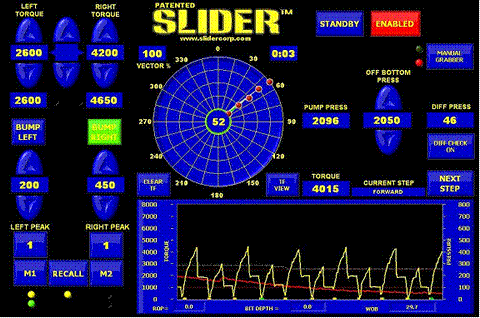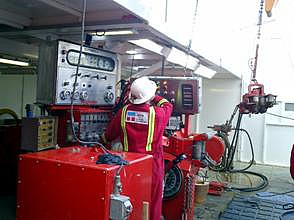Directional drilling is primarily accomplished today with either a rotary steering system or with a conventional steerable mud motor in tandem with a measurement-while-drilling (MWD) system. Rotary systems are highly efficient and make for a smooth wellbore but are extremely costly. High day rates for rotary systems rule them out for most onshore and marginal offshore wells. Steerable mud motor/MWD systems are affordable but often bog down(the hole becomes “sticky”) in the “sliding” mode —when the downhole motor is used to transmit power to the drill bit, without rotating the drill pipe, to drill a tangent section. Directional drillers often use a rocking motion to reduce drill pipe stickiness and improve rate of penetration (ROP). Commencing a slide and reorienting the tool face thus invariably entails costly rig downtime and increases the risk of wellbore failure during such an intervention.
Results
Field tests of the Slider technology in the Austin chalk showed that the system increased sliding ROP by 60-200% for estimated savings of 11-23% of total well costs. America’s oil and gas production continues to decline, even as demand for both continues to rise, increasing U.S. dependence on imported supplies. Meanwhile, service/supply costs still escalate in a capacity-constrained industry. To tackle the job of recovering more oil and gas from the world’s most mature petroleum province amid this business environment, producers need every efficiency and cost advantage they can find. Significant well-cost savings such as the Slider technology provides thus offers another research opportunity to enhance the Nation’s energy security.
Benefits
The Slider technology demonstrated these benefits in the sliding mode:
- Improved ROP and horizontal-reach capability through automated rocking, using torque as an input.
- Improved tool-face correction through a torque pulse method, using the drillstring.
- Enhanced well trajectory through an order-of-magnitude improvement in tool-face correction while on bottom.
- Avoided orientation time losses through a semi-automated transition from rotating to sliding.
- Virtually eliminated stalling, thus extending motor and bit life.
Summary
Slider is a new, patented tool that controls torque from the surface with a combination of hardware and software that integrates surface and MWD data to automate rocking during sliding. The Slider system works over the pipe rotation equipment of top drives, power swivels, or silicon-controlled rectifier (SCR)-driven rotary tables. No equipment is added downhole.
After developing a laboratory-scale physical simulator and conducting initial field tests, Slider LLC sought to extend the technology beyond initial field tests that involved a hydraulic power swivel.
NETL contributed funding to a Drilling Engineering Association joint industry project—also funded by Chevron Corp. and Anadarko Petroleum Corp.—that called for the following:
- Modifying the Slider software to accommodate electric top-drive drilling systems.
- Building a two-robot system and testing related robot software.
- Conducting at least three field tests to validate the technology on electric top drives.
- Documenting the cost-effectiveness of the technology.
- Developing a new computer torque-and-drag program that incorporates the rocking effect.
In addition, Slider LLC built a plug interface that eliminated the need for robots, trained directional drillers for the field tests, and analyzed the results from the three field tests.






